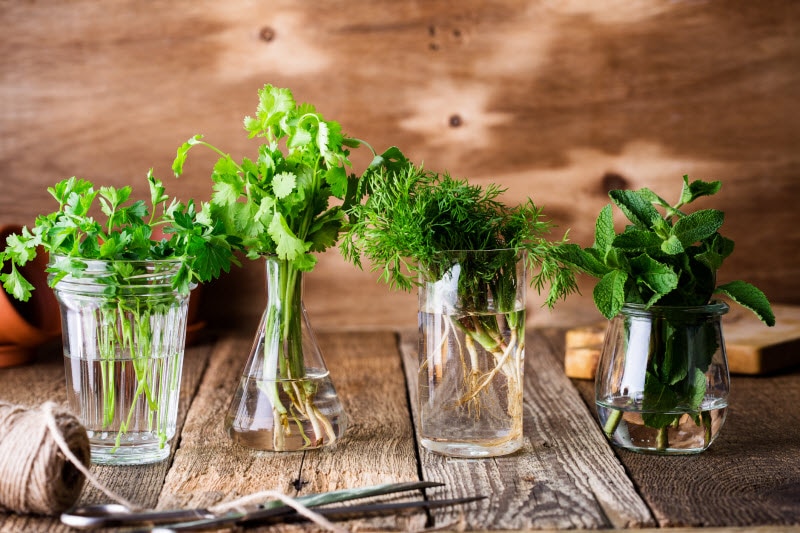You’ve got your Monstera, fiddle leaf fig, snake plant and string of pearls. Your living room is a veritable jungle, with lush and unique greenery everywhere you look. There’s a spot for every plant — and a plant for every spot. But, have you considered growing underwater plants?
If you’re looking for a new and interesting plant idea, consider creating an indoor water garden. Along with some striking new plant decor, you can grow herbs and garnishes — such as beet greens and carrots — for culinary creativity and a healthy boost to your homemade dishes.
What’s an indoor water garden?
Indoor water gardens consist of aquatic plants grown inside transparent (typically glass or plastic) containers. These plants are just like other plants, only instead of growing in soil – they grow entirely in water. Not a speck of soil required!
Why build an indoor water garden?
Besides being a fun activity for you (and your kids or grandkids), growing water plants is great because:
- They’re inexpensive to cultivate and relatively easy to maintain
- They’re disease and pest-resistant
- They create unique visual interest in any room and allow for lush, year-round greenery
- They offer a way to repurpose and reuse glass jars and clear plastic containers
Three main categories of water plants
Aquatic plants come in several varieties. Keep in mind most of these plants will need plenty of light – between 12 and 16 hours – every day for best growth. Windowsills are the perfect place to house an indoor garden once it’s complete.
The three main types of aquatic plants include:
1. Submergent
True aquatic plants, their foliage is fully submerged in water and usually anchored in gravel or sand. Examples of submergent plants include:
- Argentine sword fern
- Java fern
- Java moss
- Fittonias
- Water hyssop
2. Semi-aquatic
Also called emergent plants, their roots are anchored in water, but their foliage grows above the surface. Examples of semi-aquatic plants include:
- Heat-leaf philodendron
- Pothos
- Sweet flag
- Lucky bamboo
- Umbrella papyrus
- Cyperus grass (Prince Tut and King Tut)
Herbs include:
- Lettuce
- Green onions and chives
- Celery
- Bok choy
- Fennel
- Lemongrass
- Garlic sprout
- Beet and carrot greens
3. Floaters
Somewhat of a combination of the two previous types, these plants like to float on the water’s surface, with their roots dangling below. Examples of floaters include:
- Water lettuce
- Water hyacinth
How to make a water garden
Step One: Gather your supplies
- Choose a water plant from one of the three categories above. Look for aquatic plants at your local pet store, in the aquarium section.
- A clear jar, vase or empty container that will hold water
- Aquatic plant food tablets or a water-soluble fertilizer
- Separate jug (for pouring water and fertilizer into your container)
- Filtered water (for the clearest water possible)
If using submergent plants:
- Aquatic gravel/sand
- Decorative rocks, pebbles, stones or marbles
Step Two: Get your hands wet
Submergent plants
- Remove the plant from its packaging and gently rinse the root system.
- Rinse aquatic gravel thoroughly (until water running through is completely clear).
- Pour a 1″ to 2” base of aquatic gravel into your container, then make a small ‘well’ where you’ll place the plant.
- Carefully place your plant in the well and gently pack down gravel around to secure.
- Following directions on fertilizer package, combine fertilizer/plant food with water in separate jug.
- Pour filtered, room temperature water into the container, taking care to not dislodge the plant. Make sure foliage is completely submerged in water.
- If the plant has moved, carefully adjust with a long utensil (such as a butter knife). Lastly, drop in some decorative pebbles or marbles at the base of the plant.
Semi-aquatic plants and floaters
- Following directions on fertilizer package, combine fertilizer/plant food with water in separate jug.
- Carefully pour filtered, room temperature water into the container.
- Gently place your emergent or floater plant into the water, making sure the roots are submerged.
Step Three: Maintain your underwater adventure
Submergent, floaters and some semi-aquatic plants
- To avoid algae and other bacteria growth, be sure to replace the water every two to three weeks. During replacement, remember to wash the gravel/decorative stones.
- Prune any yellowing or browning leaves during each water replacement.
- Fertilize each time the water is changed.
Semi-aquatic plants (such as herbs)
- For herbs, replace water every day to make sure they’re free of bacterial growth.
- Prune any yellowing or browning leaves during each water replacement.
- When foraging, be careful not remove too much greenery, as it may kill the plant. Remove small amounts intermittently.

